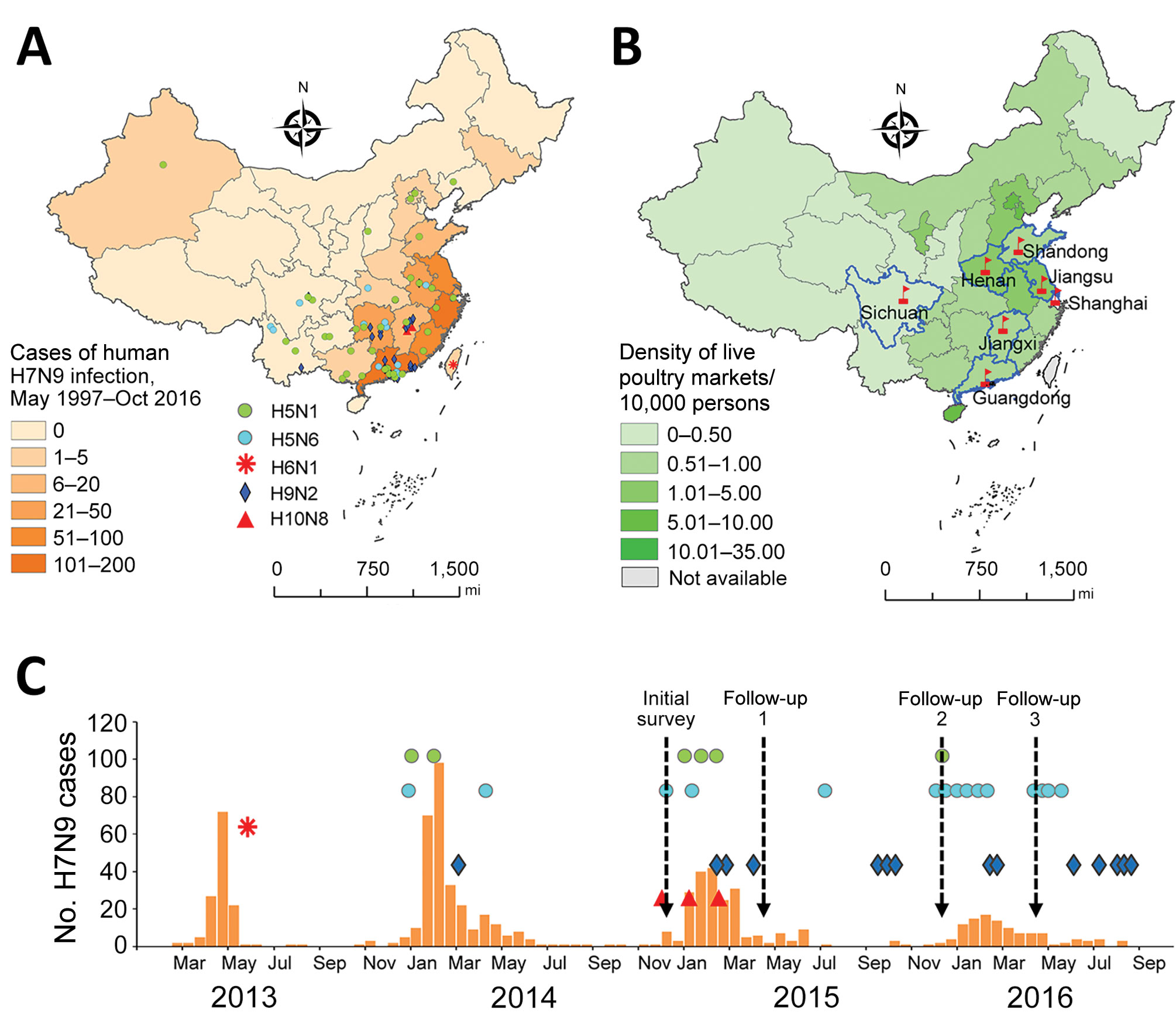Avian Influenza A Viruses among Occupationally Exposed Populations, China, 2014–2016
Chuansong Quan
1, Qianli Wang
1, Jie Zhang, Min Zhao, Qigang Dai, Ting Huang, Zewu Zhang, Shenghua Mao, Yifei Nie, Jun Liu, Yun Xie, Baorong Zhang, Yuhai Bi, Weifeng Shi, Peipei Liu, Dayan Wang, Luzhao Feng, Hongjie Yu

, William J. Liu

, and George F. Gao

Author affiliations: National Institute for Viral Disease Control and Prevention, Chinese Center for Disease Control and Prevention, Beijing, China (C. Quan, J. Zhang, P. Liu, D. Wang, W.J. Liu, G.F. Gao); Shandong First Medical University & Shandong Academy of Medical Sciences, Jinan, China (C. Quan, W. Shi); Fudan University School of Public Health, Shanghai, China (Q. Wang, H. Yu); Institute of Microbiology, Chinese Academy of Sciences, Beijing (M. Zhao, Y. Bi, G.F. Gao); Jiangsu Provincial Center for Disease Control and Prevention, Nanjing, China (Q. Dai); Sichuan Provincial Center for Disease Control and Prevention, Chengdu, China (T. Huang); Dongguan Municipal Center for Disease Control and Prevention, Dongguan, China (Z. Zhang); Shanghai Municipal Center for Disease Control and Prevention, Shanghai (S. Mao); Henan Provincial Center for Disease Control and Prevention, Zhengzhou, China (Y. Nie); Zaozhuang Center for Disease Control and Prevention, Zaozhuang, China (J. Liu); Jiangxi Provincial Center for Disease Control and Prevention, Nanchang, China (Y. Xie); Aviation General Hospital, Beijing (B. Zhang); Chinese Center for Disease Control and Prevention, Beijing (L. Feng, G.F. Gao)
Main Article
Figure 1

Figure 1. Temporal and spatial distribution of human infections with avian influenza A virus subtypes before and during serosurveillance, China. A) Geographic distribution of avian influenza A(H7N9) virus infection among humans in China during May 1997–October 2016. The number of case-patients in each province is based on data published by the World Health Organization and the National Health (https://www.who.int/influenza/human_animal_interface/avian_influenza/archive/en/) and Family Planning Commission of the Republic of China (http://www.nhc.gov.cn/jkj/s2907/new_list.shtml?tdsourcetag=s_pcqq_aiomsg). Density of shading represents the number of reported avian influenza H7N9 cases in humans in each province. Cases of other AIV subtype infections are represented by other symbols. B) Density of live poultry markets per 10,000 persons in each province included in the study, from data collected during 2013–2014. Red flags indicate locations of poultry markets selected for the serosurveillance study. C) Distribution of biweekly cases of human H7N9 infection before and during serosurveillance study. Orange bars indicate the number of biweekly cases of human H7N9 infection. Dashed lines indicate initial survey and follow-up dates for serosurveys, which were conducted before and after the third and fourth wave H7N9 epidemics. Reported cases of H5N1, H5N6, H6N1, H9N2, and H10N8 infection are noted with symbols as in panel A. AIV, avian influenza virus.
Main Article
Page created: November 18, 2019
Page updated: November 18, 2019
Page reviewed: November 18, 2019
The conclusions, findings, and opinions expressed by authors contributing to this journal do not necessarily reflect the official position of the U.S. Department of Health and Human Services, the Public Health Service, the Centers for Disease Control and Prevention, or the authors' affiliated institutions. Use of trade names is for identification only and does not imply endorsement by any of the groups named above.
